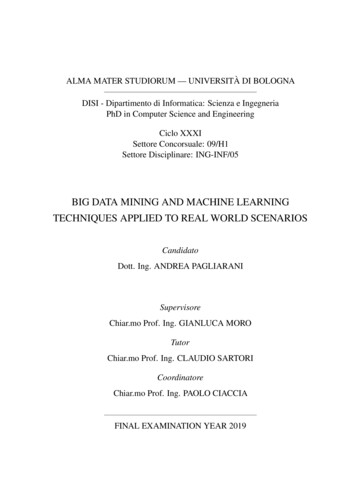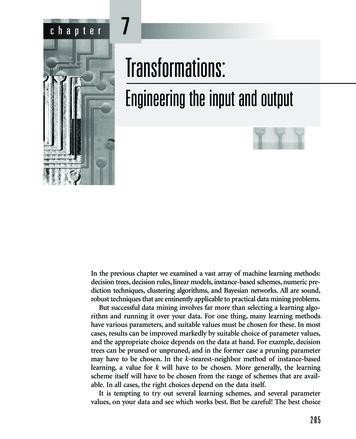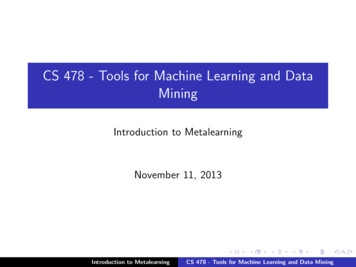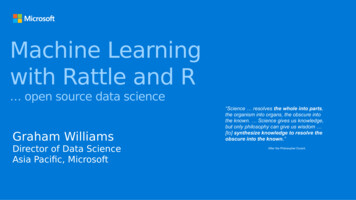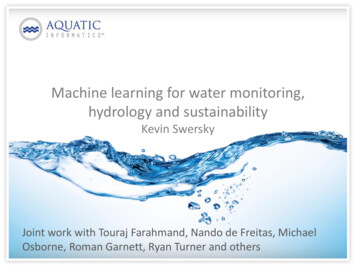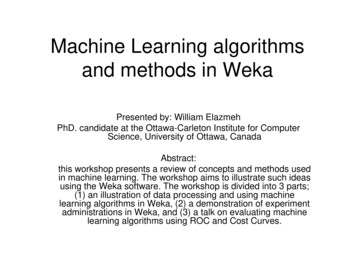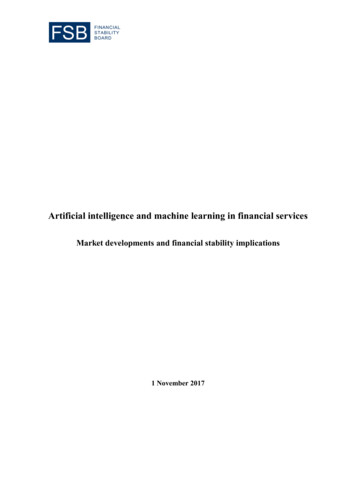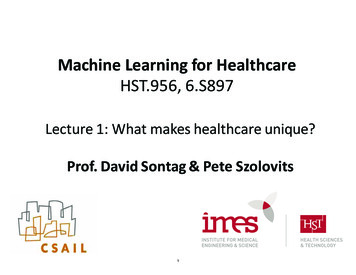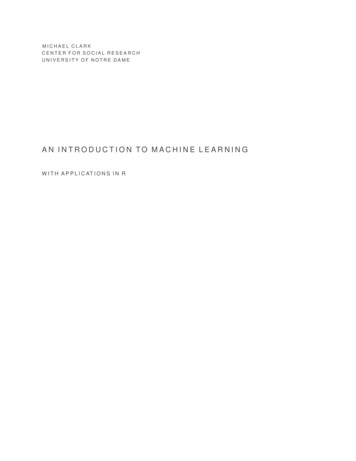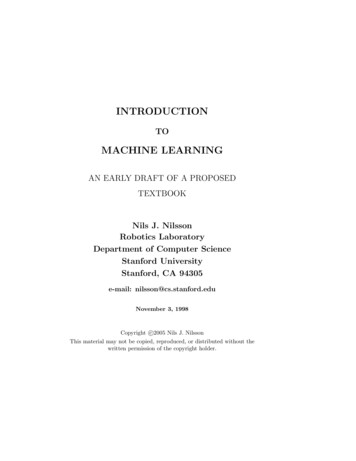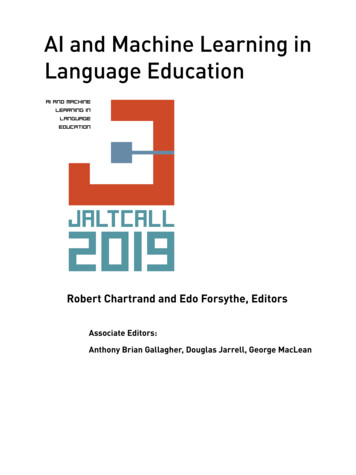
Transcription
AI and Machine Learning inLanguage EducationAI and machinelearning inlanguageeducationRobert Chartrand and Edo Forsythe, EditorsAssociate Editors:Anthony Brian Gallagher, Douglas Jarrell, George MacLean
ISBN 978-4-901352-61-1AI and Machine Learning in Language EducationSelected papers from the JALTCALL2019 Conference, Tokyo, Japan.JALT CALL is a Special Interest Group (SIG) of the Japan Association for Language Teaching(JALT) that focuses on Computer-Assisted Language Learning (CALL) and technology inlanguage learning.http://jaltcall.org/JALT is dedicated to the improvement of language teaching and learning.JALT Central OfficeUrban Edge Bldg. 5F, 1-37-9 Taito, Taito-ku, Tokyo 110-0016, Japanhttp://jalt.org/ 2019 by the JALT CALL SIG and individual authors.First published in Japan in 2019 by the JALT CALL SIG.Layout by Paul Mason
PrefaceTechnology and language teaching & learning have been the subject of much discussion and research in the past forty years as the advent of computers brought new technology to a wide range oflanguage learners. The development of CALL programs has steadily improved with the exponential increase in power and speed of computing to the point where currently multimedia applications, speechrecognition, and the integration of artificial intelligence with machine learning has certainly made aremarkable impact on language education. To this end, JALTCALL2019 highlighted the cutting edgeof language learning technology through a wide variety of presentations and workshops about currentresearch into the theory and practice of AI and machine learning in language education. This volumeof collected papers provides a good sample of the research and practice pertaining to the conferencetheme. Fourteen papers were chosen to be included in this work and they feature wide-ranging topicssuch as digital storytelling, video-based self-reflection, factors affecting Quizlet, content language integrated learning, WordPress in teacher education, smartphone addiction, online courses, Facebookgroups, learner abstracts and corpus linguistics, useful materials for listening practice, Instagram andeducation, a microblog corpus using Tumblr, speaking with your computer, and syllabic typing forlanguage learning.The papers contained herein have been double-blind peer reviewed and chosen for publicationaccording to their quality, suitability and academic relevance to CALL research. The editors workedwith the authors to improve their manuscripts for publication in this volume of collected papers. TheEditors-in-Chief hope that the readers of this volume will find these papers insightful, useful, andpractical for language teachers in Japan and around the world.We would like to thank the authors who worked diligently to provide well-researched studies andpractically-focused papers with the common theme of CALL. Additionally, this book would not bepossible without the dedication of our volunteer associate editing staff. We are greatly appreciative oftheir efforts in working with the authors to hone their manuscripts.Editors-in-ChiefRobert Chartrand, PhD, Kurume UniversityEdo Forsythe, EdD, Hirosaki Gakuin UniversityFrom the SIG Coordinator and JALTCALL2019 Co-ChairFirst of all, thank you for making JALTCALL2019 at Aoyama Gakuin University in Tokyo a successful event. We had almost 200 participants from 16 countries and regions as well as from all overJapan. This book is a collection of papers presented and other submissions from JALTCALL2019. Wehope you enjoyed your time at JALTCALL2019 and hope to see you at JALTCALL2020 in HirosakiCity, Aomori on June 5–7, 2020.Ryan Barnes, Nagoya Gakuin Universityi
Editorial TeamEditors-in-ChiefRobert Chartrand is a professor at the Institute of Foreign Language Education, KurumeUniversity. He is interested in corpus linguistics, CALL and artificial intelligence research.Edo Forsythe is a professor and head of the Department of English Language and Literature atHirosaki Gakuin University. His research interests include MALL and the use of smartphones in language learning.Associate EditorsAnthony Brian Gallagher is a lecturer in the Faculty of Foreign Studies at Meijo University. Hisresearch specialty is: the user experience in quality assurance; assistive, disruptive, & cosmetic technology; and virtual learning environments.Douglas Jarrell is a retired professor, formerly at Nagoya Women’s University, whose research interests include the affordances of technology for self-study and student engagement in the classroom.George MacLean is a professor at the University of the Ryukyus who previously taught in theJapanese and International School systems. His research areas include feedback, Mobile-learning andCALL. He is active in JALT at a local and national level and serves on review boards for several conferences and journals.Assistant Editors (Japanese language support)Chika Fujimoto, Komazawa University and Waseda UniversityMaki Terauchi Ho, Obihiro University of Agriculture and Veterinary MedicineHiroyuki Obari, Aoyama Gakuin UniversityLayoutPaul Mason, Aichi Gakuin UniversityTechnical Editor (website programming and design)Gary Ross, JALT CALL SIG Webmasterii
Contents1Video-based Self-reflection of English Language PresentationsChad Cottam, Kwansei Gakuin UniversityTroy Rubesch, Kwansei Gakuin University2Factors Affecting Quizlet Usage Among StudentsArmando Duarte, University of Shiga Prefecture3Negative and Positive Aspects of Using WordPress to Facilitate ReflectivePractice in Pre-service Teacher EducationJames M. Hall, Iwate University184Exploring Student Collaboration Strategies through Digital StorytellingFilms Created with Mobile DevicesBradley Irwin, Nihon University335Feasibility of Learning a Language Using a Full Online CourseMasumi Kai, University of Guam436CLIL and STEM English for Electrical and Electronic EngineersGoh Kawai, Hokkaido University587Japanese Validation of the Smartphone Addiction ScaleOlivia Kennedy, Ritsumeikan UniversitySandra Healy, Kyoto Institute of Technology758Dialogistic Stance on the Move: Published and EFL Proficiency-basedLearner Abstracts in Applied LinguisticsMing-Chia Lin, National Academy for Educational Research, Taiwan9Exploring the Motivation Spectrum with Facebook Secret GroupsChristopher Philip Madden, Seikei University10Instagram as a Means of Promotion, Communication and EducationPhilip Norton, Kyoto Sangyo University11711Listen up! Useful Materials for Intensive and Extensive ListeningLouise Ohashi, Meiji University131iii11089106
12A Microblog Corpus Using Tumblr for Understanding Japanese UniversityStudents’ EFL Writing139Robert Anthony Olexa, International Pacific UniversitySara Librenjak, International Pacific University13Speaking with Your Computer: A New Way to Practice and AnalyzeConversationGary Ross, Kanazawa UniversityStephen Henneberry, The University of ShimaneGlen Norris, Ishikawa Prefectural University14Using the QWERTY Keyboard as a Chord Keyboard: Syllabic Typing byMulti-key Strokes for Language Learning & MoreMarkus Rude, University of Tsukubaiv152168
1Video-based Self-reflection of English LanguagePresentationsChad Cottam, Kwansei Gakuin UniversityTroy Rubesch, Kwansei Gakuin UniversityAbstractThe mastery of oral presentation skills in English is often essential in the professional life ofscientists and those studying to be scientists. This paper presents the results of a study that attemptsto gauge the value of incorporating video-mediated feedback as it relates to measures of students’self-efficacy. The researchers examined the self-rating of pair presentations of 220 undergraduate university science and technology students in academic English communication courses at a private university in Japan. They compared the rubric-based self-rating scores of students from both non-assistedepisodic and video-assisted recall in separate instances. The research question addressed whether avideo-based reflection would serve as a more critical form of reflection than episodic memory alone.However, students generally rated themselves higher after watching a video of their performance, compared to their memory alone, raising further questions as to what measure and scope of self-assessmentis most effective for Japanese students to improve their oral presentation 能するかどうかということだった。 ords: Video, self-efficacy, self-assessment, presentationsThe mastery of oral presentation skills is often important in professional life (Campbell etal., 2001) and is a key competency for lifelong learning in general and higher education in particular(Boud & Falchikov, 2006). For scientists and those studying to be scientists in particular, presentationof scientific research has been called “an indispensable cornerstone of a successful scientific career”(Zanders & MacLeod, 2010). As the English language currently dominates the global scientific community, the majority of scientists will be expected and required to use it for such high-stakes presentations (Hamel, 2007). In the case of researchers from non-native English backgrounds, the alreadyanxiety-inducing situation of presenting scientific findings in public may be further exacerbated bylanguage issues (Osboe et al., 2007).This situation presents inherent challenges for L2 instructors of university students in science majors. In particular, instructors must adopt an effective and efficient instructional model for developingL2 presentation skills while still allowing adequate time and resources for acquisition of other L2 skills.1Cottam & Rubesch Video-based Self-reflection
Therefore, it is essential for the skills taught to be balanced among linguistic, non-linguistic and presentation specific skills.However, there has been little in the literature that synthesizes theory with practical pedagogy tohelp guide the process of teaching presentation skills in an L2 environment. One of the few notablestudies from De Grez et al. (2009) addresses the social cognitive perspective and self-regulated learning principles using multimedia instruction and multiple modes of feedback. They conclude theirdiscussion by remarking that “further investigation should centre on alternative elaborations of thetraining and timing of self and peer assessment. Both forms of assessment are expected to lead to agreater degree of self-regulated learning” (Nicol & Milligan, 2006). This paper presents the results ofa study which attempts to gauge the value of incorporating video-mediated self-reflection in a presentation course and integrated into a socio-cognitive framework for learning, such as those of Bandura(1997), Crookes and Schmidt (1991), Schunk (2001), and Zimmerman (2000); specifically, one thatpromotes the sequential concepts of forethought, task performance, and post-task reflection (Schunk,2001; Zimmerman, 2000).Self-efficacyDelivering a public presentation in a foreign language is a demanding and often stressful task. Thelink between language learners’ anxiety and their perception of communicative competence has beenlong established (e.g., MacIntyre et al., 1997). In short, anxious language learners perceive themselvesas poor communicators. By extension, anxious foreign-language presenters perceive themselves aspoor presenters.In his ground-breaking work on self-regulated learning, Bandura (1994) defined self-efficacy as“people’s beliefs about their capabilities to produce designated levels of performance that exercise influence over events that affect their lives” (p. 71). In other words, self-efficacy is the belief that one hasthe ability to complete a given task related to a given competency. It is important to note that self-efficacy is not a measure of a person’s global self-confidence. It measures one’s confidence in relation tospecific tasks (Bandura, 1986). Presenting in public using a foreign language is one such task.Lack of self-efficacy manifests a number of undesirable effects on performance. When engaging intasks in which they have low self-efficacy, people behave erratically and unpredictably. In addition todecreasing task performance, low self-efficacy has also been shown to foster the belief that tasks aremore demanding than they actually are. This belief may also lead to anxiety, stress, and even depression (Pajares, 1997).Bandura (1994) asserts that self-efficacy can both determine and predict the level of accomplishment attained by individuals. So, as L2 educators charged with increasing students’ communicativecompetence and task achievement ability, it seems reasonable to strive to increase students’ self-efficacy related to the task of public presentations.Self-efficacy and Japanese StudentsThis lack of self-efficacy with regard to foreign language-based tasks may be more pronounced inJapanese students. Several previous studies have pointed out that a self-effacing tendency (reflectinglow self-efficacy) is often observed among East Asian people in general and Japanese specifically (e.g.,Heine et al., 1999; Heine & Hamamura, 2007; Rian et al., 2015; Suzuki & Yamagishi, 2004; Yamagishiet al., 2010). This tendency is so prevalent that it seems to represent a common cultural trait amongJapanese students (Cutrone, 2009; Yamagishi et al., 2010). Considering this context, it seems thatJapanese students may, as a group, have higher needs for self-efficacy enhancement in foreign communication and compared to other L2 speakers of English.2Cottam & Rubesch Video-based Self-reflection
Self-assessment and ConfidenceBandura (1994) goes on to state that individual self-efficacy can be enhanced in several ways andthat “the most effective way of creating a strong sense of efficacy is through mastery experiences” (p.71). One way to provide these “mastery experiences” which augment students’ self-efficacy is to havethem practice presentations and evaluate their abilities regularly. This practice/self-assessment cyclecan be an effective tool for increasing both ability and confidence in achievement. This cycle, whichrepresents the essence of self-regulated learning, enables students to effectively prepare for a final presentation and assessment.Bandura (1994) describes self-regulation as “the exercise of influence over one’s own motivation,thought processes, emotional states and patterns of behavior” (p. 71). Self-assessment, a form ofself-regulated learning, is a common and well-validated method for increasing learning and confidencein the L2 classroom De Grez et al. (2009). De Saint Leger (2009) describes self-assessment as “a toolwell-suited to helping learners to develop appropriate goals and self-regulate or monitor their effortsaccordingly.” Falchikov (2005) advocates student involvement in the assessment of presentations as ameans to develop self-regulating skills and foster a better understanding of assessment criteria (p. 16).Asynchronous Video in the ClassroomTechnological affordances have fostered novel approaches to conducting self-assessment. In particular, the use of mobile video has provided a valuable learning tool for language learners worldwide.As a technologically advanced country, Japan has an extremely high adoption of smartphones whichcan be readily used as video recorders. It is reasonable to expect that university students would haveaccess to such devices to record video in the classroom (Toland & Mills, 2018). This creates a situationwhere students can have access to an audio-video recording of their in-class practice presentations virtually immediately after the completion of a presentation.The benefits of using video recordings for self-assessment of language learning are numerous.Richards and Farrell (2005) and Jordan (2012) point out that video can provide English languagelearners with accurate and reliable record of their presentation performance and reduce false memories. Dufon (2002) argued that a video can reliably document “gestures, facial expressions, and othervisual interactional cues [which] also provide important information both on the negotiation of meaning and the negotiation of affect” (p. 44).Mobile-video recordings have been shown to increase motivation and confidence in some Japanesestudents of English (Gromik, 2012). Other studies which adopted videotaped feedback for self-assessments also reported the attainment of improved oral presentation skills (Bourhis & Allen, 1998).Furthermore, Miles (2014) asserts that Japanese students who watched videos of their public speakingperformances could develop a greater sense of autonomy via the self-reflective process.Research QuestionThe researchers were interested in ascertaining whether watching a video of their performanceduring an oral presentation would raise or lower students’ self-efficacy as measured by self-assessmentvia a familiar rubric. Although the self-efficacy of the subject population (mainly male Japanese university students) may be generally lower, the cycle of presenting, reflecting, assessing, then watching,reflecting and re-assessing with video using a standard rating scale, may affect the cultural bias of students that tends to accompany low self-efficacy.3Cottam & Rubesch Video-based Self-reflection
MethodThe study involved the self-rating of individual performance in pair presentations of 220 undergraduate university science and technology students in intact, required academic English communication courses in 11 separate classes, organized by majors. The majors included Bioscience, BiomedicalChemistry, Physics, Informatics, Nanotechnology, Mathematics and Applied Chemistry. The participants’ ages ranged between 18 and 21 years old, with TOEIC scores ranging between 350 and 750.Class sizes were between 19 and 26 students per class.The course goals for each academic year included the advancement of academic presentation skills,as well as general and academic listening skills, and general discussion and conversation skills. Thepresentation skills emphasized were chosen to maximize student performance for science-based presentations (i.e., preparing graduates for presenting their research at scientific conferences in English).These presentation skills included physical aspects such as eye contact, posture, and gestures; as wellas more language-based aspects such as voice control, enunciation, and effective use of transitions.Following the curriculum guidelines of the course, throughout the semester students were requiredto research, write, practice, and deliver two “practice presentations” on a science-based topic, in pairswhile in front of small groups.As a final assessment of their presentation skills, students were required to give a 5-minute pairpresentation on a science-based topic. All participants delivered the presentation twice. The first attempt was classed as a “practice presentation” and delivered in front of small groups of 6–9 students,depending on specific class size. At this time, all participants’ full practice presentations were video-recorded by peers using the presenters’ mobile video devices (smartphones). Immediately after theirpresentations, all participants were asked to initially reflect on and assess their own performance usingthe familiar standardized rubric (used for all presentations throughout the semester) by rating eachcomponent of their performance, on a 1–5 Likert scale (see Appendix A). The rubric involved bothverbal and non-verbal aspects of their presentation performance.After all students delivered their presentations, they then watched
research into the theory and practice of AI and machine learning in language education. This volume . The mastery of oral presentation skills is often important in professional life (Campbell et al., 2001) and is a key competency for lifelong learni

